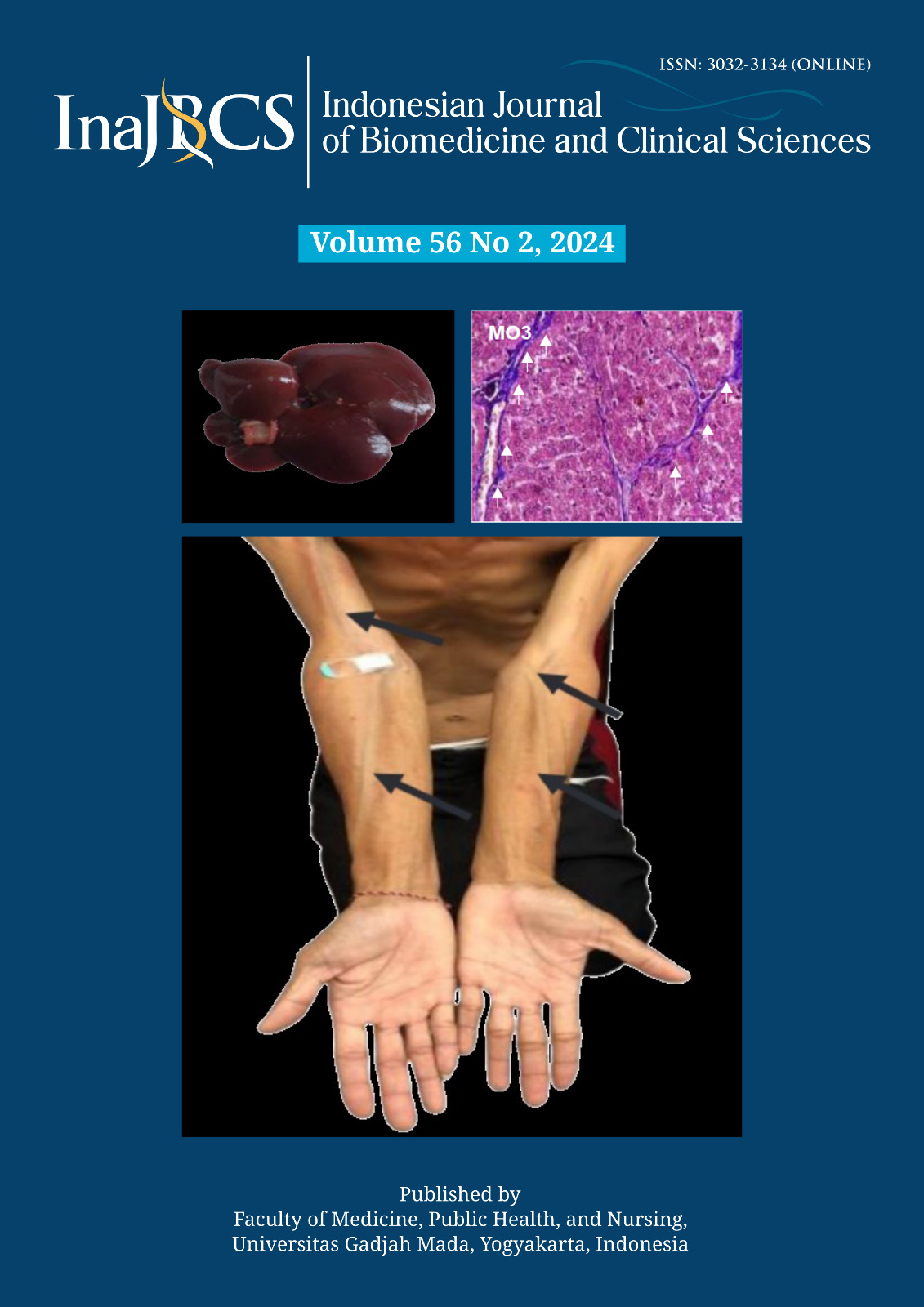The effect of infection on mortality in acute coronary syndrome patients at Dr. Sardjito General Hospital, Yogyakarta
Abstract
Ischemic heart disease is the second most significant health burden in Indonesia and the world. The prevalence of coronary heart disease patients in Yogyakarta is predicted to experience a continuous increase. In Sardjito Hospital, mortality rate of acute coronary syndrome (ACS) patients reaches 15%, with pneumonia infection identified as one of the predictors. Despite this high mortality rate, there is a lack of studies addressing the contribution of infectious comorbidities to mortality incidence among ACS patients. This study aimed to investigate the e ffect of infectious comorbidities on the incidence of mortality among ACS patients and its mortality rate in Sardjito Hospital. This study used a cross-sectional design in 794 patients diagnosed with ACS and registered in the SCIENCE registry from January to December 2022 at Sardjito Hospital. The analysis was conducted using the Chi-square method to determine the effect of infectious comorbidities on mortality among ACS patients and a logistic regression test to evaluate the correlation between variables. Based on bivariate analysis, it was found that infectious comorbidities increased mortality rate among ACS patients (p<0.001, OR=2.22[1.46-3.38]), reaching 5.2%. The bivariate analysis between confounding factors and outcome of patients showed that obesity, dyslipidemia, and revascularization significantly influenced the results of ACS patients. Based on multivariate analysis, it was discovered that infectious comorbidities, obesity, diabetes, dyslipidemia, and revascularization had a significant association with mortality of patients with ACS. Furthermore, infectious comorbidities increased the odds of mortality for ACS patients by 2.04 times. Infectious comorbidities increased the incidence of mortality in ACS patients by 2.04 times with mortality rate of 5.2%.
References
World Health Organization. Cardiovascular Diseases (CVDs) [Internet]. Who.int. World Health Organization: WHO; 2021.
https://www.who.int/en/news-room/fact-sheets/detail/cardiovascular-diseases-(cvds)
GBD 2019 Diseases and Injuries Collaborators. Global burden of 369 diseases and injuries in 204 countries and territories, 1990-2019: a systematic analysis for the Global Burden of Disease Study 2019. Lancet 2020; 396(10258):1204-22.
https://doi.org/10.1016/S0140-6736(20)30925-9.
Badan Penelitian dan Pengembangan Kesehatan Kementerian Kesehatan Republik Indonesia. Riskesdas. 2013: 127.
Kasper DL, Fauci AS, Hauser SL, Longo DL, Jameson JL, Loscalzo J. Harrison's principles of internal medicine. 19th ed. McGraw Hill Professional; 2015.
Santos M, Oliveira M, Vieira S, Magalhães R, Costa R, Brochado B, et al. Predictors and mid-term outcomes of nosocomial infection in ST-elevation myocardial infarction patients treated by primary angioplasty. Kardiol Pol 2021; 79(9):988-94.
https://doi.org/10.33963/KP.a2021.0058
Liu ES, Chiang CH, Hung WT, Tang PL, Hung CC, Kuo SH, et al. Comparison of long-term mortality in patients with acute myocardial infarction associated with or without sepsis. Int J Infect Dis 2019; 79:169-78.
https://doi.org/10.1016/j.ijid.2018.11.021
Bagaswoto HP, Ardelia YP, Setianto BY. First 24-h Sardjito Cardiovascular Intensive Care (SCIENCE) admission risk score to predict mortality in cardiovascular intensive care unit (CICU). Indian Heart J 2022; 74(6):513-8.
https://doi.org/10.1016/j.ihj.2022.11.002
Bagaswoto HP, Taufiq N, Setianto BY. A simplified risk scoring system to predict mortality in cardiovascular intensive care unit. Cardiol Res 2019;10(4):216-22.
https://doi.org/10.14740/cr884
Ellis CJ, Gamble GD, Williams MJA, Matsis P, Elliott JM, Devlin G, et al. All-cause mortality following an acute coronary syndrome: 12-year follow-up of the comprehensive 2002 New Zealand acute coronary syndrome audit. Heart Lung Circ 2019; 28(2):245-56.
https://doi.org/10.1016/j.hlc.2017.10.015
Levi M. Infection and inflammation and the coagulation system. Cardiovas Res 2003; 60(1):26-39.
https://doi.org/10.1016/S0008-6363(02)00857-X
Chioncel O, Parissis J, Mebazaa A, Thiele H, Desch S, Bauersachs J, et al. Epidemiology, pathophysiology and contemporary management of cardiogenic shock - a position statement from the Heart Failure Association of the European Society of Cardiology. Eur J Heart Fail 2020; 22(8):1315-41.
https://doi.org/10.1002/ejhf.1922
Karkabi B, Khoury R, Zafrir B, Jaffe R, Adawi S, Lavi I, et al. Causes of mortality in a department of cardiology over a 15-year period. IJC Heart Vasc 2021;32:100692.
https://doi.org/10.1016/j.ijcha.2020.100692
Njoroge JN, Teerlink JR. pathophysiology and therapeutic approaches to acute decompensated heart failure. Circulation Research 2021; 128(10):1468-86.
https://doi.org/10.1161/CIRCRESAHA.121.318186
Poirier P, Giles TD, Bray GA, Hong Y, Stern JS, Pi-Sunyer FX, et al. Obesity and cardiovascular disease: pathophysiology, evaluation, and effect of weight loss: an update of the 1997 American Heart Association Scientific Statement on Obesity and Heart Disease from the Obesity Committee of the Council on Nutrition, Physical Activity, and Metabolism. Circulation 2006; 113(6):898-918.
https://doi.org/10.1161/CIRCULATIONAHA.106.171016
Niedziela J, Hudzik B, Niedziela N, Gąsior M, Gierlotka M, Wasilewski J, et al. The obesity paradox in acute coronary syndrome: a meta-analysis. Eur J Epidemiol 2014; 29(11):801-12.
https://doi.org/10.1007/s10654-014-9961-9
Kadakia MB, Fox CS, Scirica BM, Murphy SA, Bonaca MP, Morrow DA. Central obesity and cardiovascular outcomes in patients with acute coronary syndrome: observations from the MERLIN-TIMI 36 Trial. Heart 2011; 97(21):1782-7.
https://doi.org/10.1136/heartjnl-2011-300231
Duan JG, Chen XY, Wang L, Lau A, Wong A, Thomas GN, et al. Sex differences in epidemiology and risk factors of acute coronary syndrome in Chinese patients with type 2 diabetes: a long-term prospective cohort study. PLoS One. 2015; 10(4):e0122031.
https://doi.org/10.1371/journal.pone.0122031.
Feingold KR. Obesity and dyslipidemia. Feingold KR, Anawalt B, Blackman MR, Boyce A, Chrousos G, Corpas E, et al., editors. PubMed. South Dartmouth (MA): MDText.com, Inc.; 2000.
https://pubmed.ncbi.nlm.nih.gov/26247088/
Truffa AA, Granger CB, White KR, Newby LK, Mehta RH, Hochman JS, et al. Serious infection after acute myocardial infarction: incidence, clinical features, and outcomes. JACC Cardiovasc Interv 2012; 5(7):769-76.
https://doi.org/10.1016/j.jcin.2012.03.018
Babes EE, Bustea C, Behl T, Abdel-Daim MM, Nechifor AC, Stoicescu M, et al. Acute coronary syndromes in diabetic patients, outcome, revascularization, and antithrombotic therapy. Biomed Pharmacother 2022; 148:112772.






